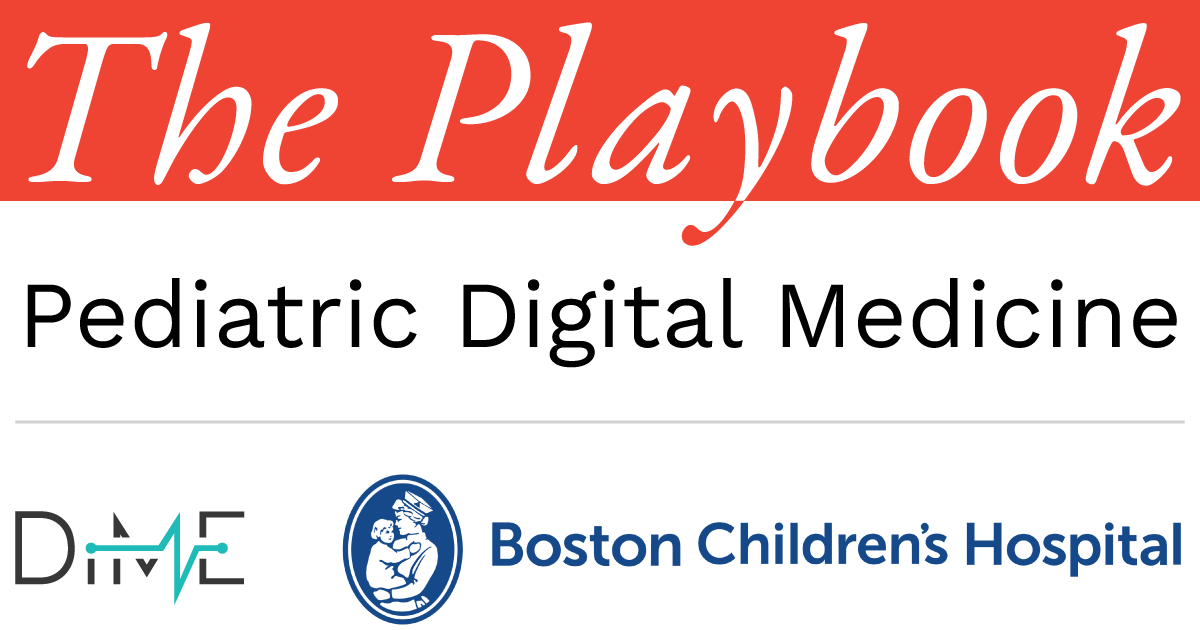
Chapter 3 – Section 4
Key considerations & strategies for success

As you move through the various phases of pediatric DHT implementation, several critical elements will determine the success and sustainability of your technology. These considerations span all stages of implementation and directly impact adoption, effectiveness, and the long-term success of DHTs in pediatric care.
This section presents The Playbook project team’s key considerations for success, including:
- Driving clinician adoption
- Supporting patients and caregivers
- Data management, privacy and security
- Continuous improvement and monitoring
- Regulatory considerations
Drive clinician adoption

For DHTs to succeed in pediatric care settings, clinicians must be onboard and confident in using these technologies. The adoption process is a multifaceted challenge that requires proper training, integration into workflows, and building trust in the technology’s ability to enhance clinical outcomes. Clinician engagement is critical, not only to ensure adoption but to facilitate the long-term success of the technology.
Follow these strategies to drive clinician adoption

Provide tailored training
- Role-specific training: Develop training materials tailored to the unique needs of each role, whether clinicians, school nurses, or other specialists. Consider their varying levels of technical expertise and medical knowledge.
- Hybrid training: A mix of in-person and online resources can accommodate different schedules and learning preferences.
- Above all else, tools should be intuitive and integrate seamlessly with doctors’ workflows. Include them as key partners in your product development and implementation.
Empower clinician champions
- Identify early advocates: Engage clinicians who are open to digital tools early on and equip them with extra training to become DHT champions.
- Peer training: Encourage champions to share their experiences and lead training sessions, making adoption feel more organic and community-driven.
- Incentives and engagement: Provide leadership opportunities, research collaboration, and continuous involvement in product feedback. It can keep champions motivated and deeply engaged in DHT use.
Integrate with clinical workflows
- Electronic EHR integration: DHTs should integrate smoothly with existing EHR systems to ensure efficient use and data sharing.
- Co-design with clinicians: Ensure that DHTs fit seamlessly into the daily routines of pediatric care providers. Involve them early in design and decision-making to minimize disruption.
- Actionable data: Present data in clear, concise formats, focusing on insights that directly aid clinical decision-making without overwhelming providers.
Build trust
- Clinical benefits: Emphasize how DHTs improve patient outcomes—such as better management of chronic conditions or earlier detection of developmental concerns.
- Share success stories: Use peer-reviewed case studies and success stories to help overcome skepticism and build trust.
- Encourage feedback loops: Encourage continuous feedback from clinicians to adapt the technology to their needs and address concerns promptly, ensuring they feel heard and supported.
Case studies

Electronic Health Record (EHR):
EHRs contain individual health records for patients and are used in care delivery. Generally maintained by health care providers, health care organizations, and health care institutions and are used to deliver care. Can be used to integrate real-time electronic health care information from medical devices and multiple health care providers involved in care of patients.

Meet Dr. Johnson
Personas illustrate key points in action, showcasing real-world applications and practical scenarios based on fictional personas.

Meet Ryan
Personas illustrate key points in action, showcasing real-world applications and practical scenarios based on fictional personas.
Support patients and caregivers

Supporting pediatric patients and caregivers in the effective use of DHTs is essential for realizing their full potential in improving health outcomes. Ensure solutions are culturally sensitive, simplify caregiver tasks, and provide continuous educational support. In this process, DHTs can significantly improve the care experience for both patients and caregivers. As children grow and their relationships with technology evolve, these strategies help ensure that families are able to fully engage with and benefit from digital health innovations.

Key takeaways
Did you know?
Only 22% of the U.S. population is considered proficient in health literacy.
When supporting patient and caregiver utilization of DHTs, consider how to convey complex information to diverse audiences. This diversity includes varying ages, literacy levels, and languages. Develop content at a 5th grade reading level to ensure ease of understanding among patients and their caregivers.
Implement with accessibility and privacy in mind

Ensure accessibility
- Co-design solutions: Collaborate with patients, caregivers, and community stakeholders to design DHTs that are both functional and accessible.
- Consider health literacy: Incorporate simple language, visual aids, and intuitive interfaces to ensure that solutions are easy to navigate for users with varying levels of literacy.
- Offer multilingual support: Translate user interfaces, instructions, and educational content into multiple languages to overcome language barriers and ensure broad accessibility.
- Improve access to technology: Consider all settings of care (e.g., home, schools) as a site of access and develop strategies to overcome barriers and ensure adequate access to devices and internet connectivity.
Ensure privacy and confidentiality
- Balance privacy and support: Implement privacy settings that respect the evolving autonomy of children as they age while allowing caregivers the access needed to support care. Educate both adolescents and caregivers about privacy rights and responsibilities.
- Confidentiality protocols: Maintain compliance with relevant laws and regulations, especially for adolescents, to ensure the protection of sensitive health information while facilitating appropriate access for caregivers and providers.
Support families as they change

Educate and communicate with patients and caregivers
- Early education: Provide educational opportunities early in the patient journey—ideally during onboarding—to ensure that patients and caregivers feel empowered and prepared to use the DHT effectively.
- Communication channels: Use accessible communication tools like SMS, in-app messaging, or telehealth options to maintain regular contact between caregivers, patients, and healthcare providers.
- Demonstrate value: Share treatment progress and outcomes with families to keep them engaged in their child’s health journey and to build trust in the DHT’s value.
- Streamline processes: Minimize the paperwork and repetitive data entry that often burden caregivers by automating routine tasks, reducing forms, and pre-filling information where possible.
Continuity of care
- Facilitate seamless transitions: Facilitate smooth transitions from pediatric to adult care by ensuring that digital health records are comprehensive and transferable across care providers.
- Coordinate caregivers: Recognize the multiple caregivers involved in pediatric care and develop strategies for coordinating their access to digital tools and ensuring open communication.
Case studies



Meet Parker
Personas illustrate key points in action, showcasing real-world applications and practical scenarios based on fictional personas.
Data management, privacy, and security

As DHTs gain prominence in pediatric care, it is essential to safeguard data privacy and security. Given children’s unique privacy needs, evolving rights over time, and the potential long-term impacts of a digital health footprint, careful management of their health data is critical. Use the strategies in this section to protect pediatric data, balance access and security, and learn how to use data responsibly to support research while preserving privacy and building trust with families.
Balance data access with security

Data protection and access
- Robust security measures: Implement strong encryption, secure authentication, and data anonymization to protect sensitive information throughout collection, transmission, and storage.
- Role-based access controls: Assign access levels based on user roles (e.g., clinicians, caregivers, patients) to balance data accessibility with security. This approach ensures that all users have access only to the information they need.
- Age-appropriate access: Design systems that transition control of health data from caregivers to patients as they reach adolescence, reflecting children’s evolving privacy rights.
Build trust through transparency
- Privacy-first development: Integrate privacy protections from the outset of DHT development, ensuring that data security is a core feature, not an add-on.
- Transparent privacy settings: Provide easy-to-understand privacy options, allowing families to make informed choices about data sharing and access.
- Accessible support: Offer channels to easily adjust privacy settings or request data deletion, making privacy management straightforward and accessible.
Case studies

Leverage pediatric data

Leverage data for research and continuous improvement
- De-identification: Anonymize data to allow for research use while preserving patient privacy.
- Opt-in/out for research: Empower families to decide if their child’s data can contribute to research, reinforcing their control over data use.
- Clear incident response: Have a transparent plan for handling breaches, ensuring swift communication and action to protect users.
- Feedback-driven updates: Collect input from patients, caregivers, and providers to respond to new privacy and security needs.
- Proactive security monitoring: Stay ahead of emerging threats by regularly updating security protocols.
- Longitudinal data: Use DHTs to track long-term health outcomes for pediatric patients, particularly those with chronic conditions, and provide analytics that highlight areas for clinical intervention.
- Establish strategic partners: Partner with researchers to analyze aggregated outcome data, identifying trends and opportunities for public health interventions or policy changes.
Foster a culture of continuous improvement and monitoring

Adapt to children’s evolving health needs, technological advancements, and emerging clinical insights to ensure pediatric DHTs remain relevant and effective. This process requires ongoing monitoring, regular updates, and close collaboration with stakeholders. Foster a culture of continuous improvement, and these technologies can better serve pediatric patients, caregivers, and clinicians over time.
Enable user feedback and iterative improvements

Real-time feedback and iterative improvement
- Feedback loops: Establish mechanisms for collecting ongoing feedback from clinicians, caregivers, and pediatric patients, and use this input to inform updates. Consider in-app surveys for easy reporting of user experiences and suggestions, enabling continuous dialogue with end-users.
- Stakeholder collaboration: Involve pediatricians and caregivers in beta testing new features, allowing them to highlight areas for improvement before full rollout.
- Advisory groups: Form an advisory group of clinicians, caregivers, and pediatric experts to continuously assess and validate updates, ensuring improvements meet real-world needs. Involve these groups in beta testing of new features before a full rollout, allowing them to identify areas for improvement.
- Scheduled updates and patches: Implement routine updates to align with current medical guidelines, improve privacy and security, and optimize functionality.
Navigate regulatory resources
Navigating regulatory requirements is essential for the safe and compliant deployment of pediatric digital health technologies. Use this section to learn about the key U.S. agencies, guidance documents, and initiatives that support developers and implementers in delivering safe, effective, and child-centered DHTs.

Key insights
Key regulatory resources for pediatric DHTs
The FDA regulates many DHTs, particularly those with medical device functionality. Key FDA resources include:
These resources help ensure that DHTs meet high ethical and privacy standards for pediatric populations:
Additional resources and initiatives to guide your strategic decision making:
- Pediatric Device Consortia (PDC): Grants funded by the FDA to support the development and commercialization of pediatric medical devices, including DHTs.
- American Academy of Pediatrics (AAP) publishes position statements and guidelines on digital health, policy and safety, which offer best practices for pediatric DHTs.









